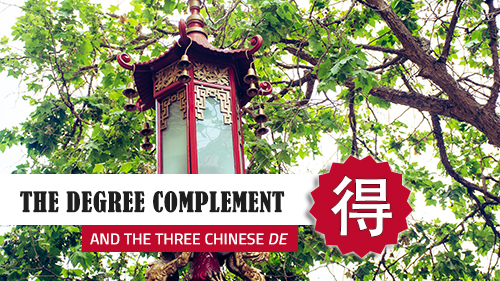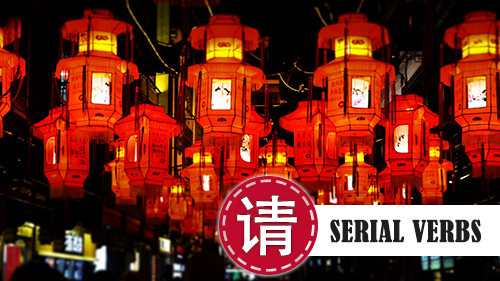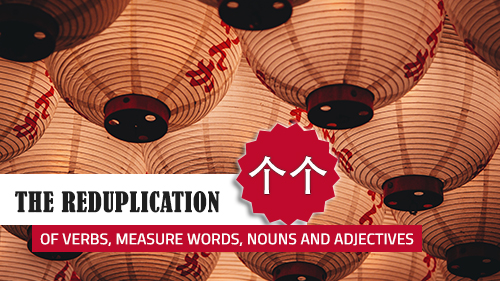Lessons
When I started studying Chinese at an evening course in 2011, it was love at first sight. Once the course ended, even if I was told that it would have been almost impossible, I continued to study it on my own buying several textbooks, watching tons of tv series in original language and keeping in touch with native guys through socials and letters, that gave a huge boost to my proficiency level of Chinese.
In this section I want to offer some lessons about linguistic and grammatical aspects of the Chinese language, hoping to arouse your curiosity and get you to become interested in this wonderful language.
-
The compound directional complement

The compound directional complement derives from the combination of the verbs 去 (qù) and 来 (lái) with other verbs like 上 (shàng) “to go up”,下 (xià) “to go down”, 出 (chū) “to go out”, 过 (guò) “to pass” and 起 (qǐ) “to get up”. These combinations are placed after the main action verb to indicate not only approaching and distancing but also a more precise direction. 上来 (shàng lái): indicates a positive outcome or the ability to do something.
-
The simple directional complement

When an action verb is followed by another verb or a combination of two verbs indicating the direction of the action of the first verb, the latter are called directional complement. The directional complement can be divided in simple and compound. The simple directional complement consists of action verbs followed by the verbs 去 (qù) and 来 (lái), which we have already discussed in the lesson The usage of 去 and 来, specifying respectively distancing and approaching with respect to the person who is talking.
-
The degree complement and the three Chinese de

In Chinese, there are three structural particles with the same sound: 的, 地 and 得. The pronunciation of all these three particles is de, but their functions are different. The first, as mentioned in the lesson Determiner and determined, suggests possession and links the determined to its determiner. 我的小狗狗很可爱。 wǒ de xiǎo gǒu gǒu hěn kě’ài [I ST little dog INT cute] My little dog is very cute. 这件红色的毛衣很适合你。 zhè jiàn hóngsè de máoyī hěn shìhé nǐ
-
The difference among 还, 又 and 再

还 (hái), 又 (yòu) and 再 (zài) all mean “again, still” and they all express the repetition of an action, but they are used differently in a sentence. 还 is used, mostly in questions, to indicate the repetition or the continuation of an action that has not occurred yet. In addition, it means “even more”. 你还不走? nǐ hái bù zǒu [you yet not to-leave] Haven’t you left yet? 你还在吃饭啊? nǐ hái zài chīfàn a
-
The difference between 有点儿 and 一点儿

有(一)点儿 (yǒu (yī) diǎn’r) and 一点儿 (yīdiǎn’r) both mean “a little” and can often be confused with each other. In fact, their use is different. 有(一)点儿, where 一 is usually omitted, is always placed before adjectives and verbs and indicates an undefined but not large amount. 现在我有点儿忙,不能来。 xiànzài wǒ yǒudiǎn’r máng, bùnéng lái [now I a-little busy not can to-come] Now I’m a little busy, I can’t come. 这个手机有点儿贵。 zhège shǒujī yǒudiǎn’r guì
-
Serial verbs

In Chinese, two verbal predicates, sharing the same subject, can follow each other without the need of conjunctions. These constructions are called constructions of serial verbs and can express a temporal sequence or an action-purpose relationship. In the first ones, the action of the second verb follows the one of the first verb, after which is usually placed the perfect particle 了, that indicates that the action is completed. 我做了功课去公园散步了。
-
The reduplication

In Chinese, verbs, measure words, nouns and adjectives can be subject to reduplication. When reduplicated, verbs are weakened and they lose part of their intensity. The action is seen as short or performed less decisively. The predicative adjectives, as to say those adjectives which imply a verbal meaning, are reduplicated according to the structure AABB; dissyllabic action verbs according to the structure ABAB and between the reduplication of monosyllabic action verbs, the character 一 (yī) “one” can be inserted.
-
The particle 了

The particle 了 (le) is perhaps the most difficult aspect of Chinese grammar to understand for any student who studies this language. Just like the particle 的 and 吗, 了 doesn’t have neither tone nor meaning, but it plays a structural role within the sentence. Depending on its position, it can be of two types: aspectual or modal. Since it can be used with reference to past, present or future events, it’s important to make clear that this particle doesn’t represent the past.
-
The aspect markers

In addition to Time Words, another characteristic of Chinese language that is useful to understand the grammatical aspect of the verb are the adverbs 正 (zhèng), 在 (zài) and 正在 (zhèngzài) and the particles 过 (guò) and 着 (zhe). The adverbs 正 (zhèng) “in the midst of (doing something)”, 在 (zài) the equivalent of the English -ing form and 正在 (zhèngzài) “to be in the process of” are used to describe an action in progress, be it in the past, in the present or in the future.
-
Dative verbs

Dative verbs are those verbs that answer the question “to whom?”, thus they designate the indirect object. There are not so many Chinese verbs of this kind and, just as happens in English grammar, the indirect object (the recipient or the beneficiary of an action) is directly linked to the verb, without the need to had prepositions between them. Here are the main ones: 给 (gěi) – to give 妈妈给我弟弟一个玩具玩。